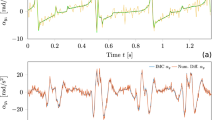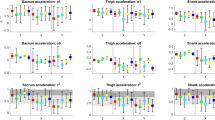Abstract
There is a need for objective and quantitative methods for measuring posture and movement, so that, for instance, exposure-response relationships for work-related musculoskeletal disorders can be established. Inclinometry data have been obtained from triaxial accelerometers based on uniaxial solid-state accelerometers used in conjunction with a computer program to perform co-ordinate transformations. The transducer can be mounted in an arbitrary orientation on a body segment, since if two reference positions are recorded, the co-ordinate system of the transducer can be transformed to that of the body segment. The angular error of the system is small (1.3°), the reproducibility is high (0.2°), and the inherent angular noise is small (0.04°) and independent of the orientation of the device. Under quasi-static conditions, the angular velocities can be derived from the inclinometry data. The angular and the angular-velocity errors can be approximated using the relative deviation of the acceleration magnitude from gravitation. For applications involving a high degree of movement, the accelerometer data are still valid, although they cannot be interpreted as inclination. Used in combination with the computer program, the transducer can be used to measure posture and movement under static and quasi-static conditions, which occur in most areas of occupational work. It is shown that spherical co-ordinates can be used to present the inclinometry data.
Similar content being viewed by others
References
Aarås, A., andStranden, E. (1988): ‘Measurement of postural angles during work’,Ergonomics,31, pp. 935–944
Åkesson, I., Hansson, G., Balogh, I., Moritz, U. andSkerfving, S. (1997): ‘Quantifying work load in neck, shoulders and wrists in female dentists,Int. Arch. Occup. Environ. Health,69, pp. 461–474
Andrews, B. J., andWilliamson, R. P. (1997): ‘The gyrogoniometer’. Proc. RESNA'97, pp. 262–264
Asterland, P., Hansson, G.-Å, andKellerman, M. (1996): ‘New data logger system for work load measurements—based on PCMCIA memory cards’. Abstracts 25th Int. Congress on Occupational Health, Stockholm, Sweden, Part I, p. 273
Bernard, B. P. (Ed.) (1997): ‘Musculoskeletal disorders and workplace factors: a critical review of epidemiological evidence for work-related musculoskeletal disorders of the neck, upper extremity, and low back’. DHHS (NIOSH), Publication 97-141
Burdorf, A. (1992): ‘Exposure assessment of risk factors for disorders of the back in occupational epidemiology,’Scand. J. Work Environ. Health,18, pp. 1–9
D'Amico, M. andFerrigno, G. (1992): ‘Comparison between the more recent techniques for smoothing and derivative assessment in biomechanics,’Med. Biol. Eng. Comput.,30, pp. 193–204
Ehara, Y., Fujimoto, H., Miyazaki, S., Mochimaru, M., Tanaka, S., andYamamoto, S. (1997): ‘Comparison of the performance of 3D camera systems II’,Gait & Posture,5, pp. 251–255
Fernström, E. A., andEricson, M. O. (1996): ‘Upper-arm elevation during office work’,Ergonomics,39, pp. 1221–1230
Giakas, G., andBaltzopoulos, V. (1997): ‘Optimal digital filtering requires a different cut-off frequency strategy for the determination of the higher derivatives’,Biomech.,30, pp. 851–855
Hagberg, M. (1992): ‘Exposure variables in ergonomic epidemiology’,Am. J. Ind. Med.,21, pp. 91–100
Hansson, G.-Å., Balogh, I., Ohlsson, K., Rylander, L., andSkerfving, S. (1996): ‘Goniometer measurements and computer analysis of wrist angles and movements applied to occupational repetitive work’,J. Electromyogr. Kinesiol.,6, pp. 23–35
Hansson, G.-Å., Balogh, I., Unge Byström, J., Ohlsson, K., Nordander, C., Asterland, P., Sjölander, S., Rylander, L., Winkel, J., andSkerfving, S. (2001): ‘Questionnaire versus direct technical measurements for assessment of postures and movements of head, upper back, arms and hands’,Scand. J. Work Environ. Health,27, pp. 30–40
Hansson, G.Å., Björn, F., andCarlsson, P. (1992): ‘A new triaxial accelerometer and its application as an advanced inclinometer’. Abstracts 9th Int. Congress of ISEK, Florence, Italy, p. 207
Hansson, G.-Å., andMikkelsen, S. (1997): ‘Kinematic evaluation of occupational work’,Adv. Occup. Med. Rehab.,3, pp. 57–69
Heyn, A., Mayagoitia, R. E., Nene, A. V., andVeltink, P. H. (1996): ‘The kinematics of the swing phase obtained from accelerometer and gyroscope measurements’. Proc. 18th Annual Int. Conf. of IEEE Eng. in Med. & Biol. Soc. Amsterdam, The Netherlands, pp. 463–464
Hsiao, H., andKeyserling, W. M. (1990): ‘A three-dimensional ultrasonic system for posture measurement’,Ergonomics,33, pp. 1089–1114
ISO/CD (1995): ‘Ergonomics—Evaluation of working postures’. Committee Draft ISO/TC 159/SC 3
Juul-Kristensen, B., Hansson, G.-Å., Fallentin, N., Hviid Andersen, J., andEkdahl, C. (2001): ‘Assessement of work postures and movements using a videobased observation method and direct technical measurements’,Appl. Ergon., (in press)
Logan, S. E., andGroszewski, P. (1989): ‘Dynamic wrist motion analysis using six degree of freedom sensors’,Biomed. Sci. Instrum.,25, pp. 213–220
Luinge, H. J., Veltink, P. H., andBaten, C. T. M. (1999): ‘Estimating orientation with gyroscopes and accelerometers’. Proc. Int. Biomechatronics Workshops, Enchede, The Netherlands, pp. 214–218
Moe-Nilssen, R. (1998): ‘A new method for evaluating motor control in gait under real-life environmental conditions. Part 1: The instrument’,Clin. Biomech.,13, pp. 320–327
Nordin, M., Örtengren, R., andAndersson, G. B. J. (1984): ‘Measurement of trunk movements during work’,Spine 9, pp. 465–469
Otun, E. O., andAnderson, J. A. (1988): ‘An inclinometric method for continuous measurement of sagittal movement of the lumbar spine’,Ergonomics,31, pp. 303–315
Seo, A., Kakehashi, M., Tsuru, S., Amran, A., Paeng, J. andYoshinaga, F. (1993): ‘Development of a system for analyzing working postures’,Ind. Health,31, pp. 69–77
Seo, A., Tsuru, S., Kakehashi, M., andYoshinaga, F. (1994): ‘A simple apparatus using inclinometer for monitoring working postures’,Jpn. J. Ind. Health,36, pp. 406–411
Seo, A., andUda, S. (1997): ‘Trunk rotation monitor using angular velocity sensors’,Ind. Health,35, pp. 222–228
Toivonen, R., Takala, E.-P., Viikari-Juntura, E., Kallio, M., andHaapio, T. (1997): ‘An accelerometer based posture detection system’. Proc. 13th Triennial Congress of International Ergonomics Association, Tampere, Finland,4, pp. 225–227
Van der Beek, A. J., andFrings-Dresen, M. H. W. (1998): ‘Assessment of mechanical exposure in ergonomic epidemiology’,Occup. Environ. Med.,55, pp. 291–299.
Van Riel, M. P. J. M., Derksen, J. C. M., Burdorf, A., andSnijders, C. J. (1995): ‘Simultaneous measurement of posture and movements of head and trunk by continuous three-dimensional registration’,Ergonomics,38, pp. 2563–2575
Willemsen, A. Th. M., Frigo, C., andBoom, H. B. K. (1991): ‘Lower extremity angle measurement with accelerometers—error and sensitivity analysis’,IEEE Trans. Biomed. Eng. 38, pp. 1186–1193
Winkel, J., andMathiassen, S. E. (1994): ‘Assessment of physical work load in epidemiologic studies: concepts, issues and operational considerations’,Ergonomics,37, pp. 979–988
Winkel, J., andWestgaard, R. (1992): ‘Occupational and individual risk factors for shoulder-neck complaints: Part II—The scientific basis (literature review) for the guide’,Int. J. Ind. Ergon.,10, pp. 85–104.
Author information
Authors and Affiliations
Corresponding author
Rights and permissions
About this article
Cite this article
Hansson, G., Asterland, P., Holmer, N.G. et al. Validity and reliability of triaxial accelerometers for inclinometry in posture analysis. Med. Biol. Eng. Comput. 39, 405–413 (2001). https://doi.org/10.1007/BF02345361
Received:
Accepted:
Issue Date:
DOI: https://doi.org/10.1007/BF02345361




